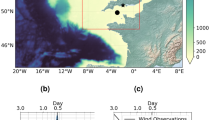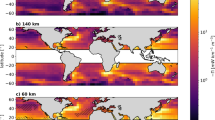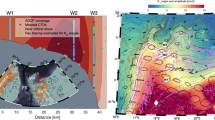Abstract
How and where the ocean tides dissipate their energy are long-standing questions1 that have consequences ranging from the history of the Moon2 to the mixing of the oceans3. Historically, the principal sink of tidal energy has been thought to be bottom friction in shallow seas4,5. There has long been suggestive evidence6,7, however, that tidal dissipation also occurs in the open ocean through the scattering by ocean-bottom topography of surface tides into internal waves, but estimates of the magnitude of this possible sink have varied widely3,8,9,10,11. Here we use satellite altimeter data from Topex/Poseidon to map empirically the tidal energy dissipation. We show that approximately 1012 watts—that is, 1 TW, representing 25–30% of the total dissipation—occurs in the deep ocean, generally near areas of rough topography. Of the estimated 2 TW of mixing energy required to maintain the large-scale thermohaline circulation of the ocean12, one-half could therefore be provided by the tides, with the other half coming from action13 on the surface of the ocean.
This is a preview of subscription content, access via your institution
Access options
Subscribe to this journal
Receive 51 print issues and online access
$199.00 per year
only $3.90 per issue
Buy this article
- Purchase on Springer Link
- Instant access to full article PDF
Prices may be subject to local taxes which are calculated during checkout


Similar content being viewed by others
References
Munk, W. H. & MacDonald, G. J. F. The Rotation of the Earth: A Geophysical Discussion (Cambridge Univ. Press, 1960 ).
Hansen, K. S. Secular effects of oceanic tidal dissipation on the moon's orbit and the earth's rotation. Rev. Geophys. Space Phys. 20, 457–480 (1982).
Munk, W. H. Once again: once again–tidal friction. Prog. Oceanogr. 40, 7–36 (1997).
Taylor, G. I. Tidal friction in the Irish Sea. Phil. Trans. R. Soc. Lond. A 220, 1–33 (1919).
Jeffreys, H. Tidal friction in shallow seas. Phil. Trans. R. Soc. Lond. A 221, 239–264 (1920).
Munk, W. H. Abyssal recipes. Deep-Sea Res. 13, 707– 730 (1966).
Bell, T. H. Topographically induced internal waves in the open ocean. J. Geophys. Res. 80, 320–327 ( 1975).
Morozov, E. G. Semidiurnal internal wave global field. Deep-Sea Res. 42, 135–148 (1995).
Wunsch, C. Internal tides in the ocean. Rev. Geophys. Space Phys. 13, 167–182 (1975).
Baines, P. G. On internal tide generation models. Deep-Sea Res. 29 , 307–338 (1982).
Sjöberg, B. & Stigebrandt, A. Computations of the geographical distribution of the energy flux to mixing processes via internal tides and the associated vertical circulation in the ocean. Deep-Sea Res. 39, 269–291 (1992).
Munk, W. H. & Wunsch, C. Abyssal recipes II: Energetics of tidal and wind mixing. Deep-Sea Res. 45, 1977–2010 (1998).
Wunsch, C. The work done by the wind on the ocean circulation. J. Phys. Oceanogr. 28, 2331–2339 ( 1998).
Gregg, M. C. Scaling turbulent dissipation in the thermocline. J. Geophys. Res. 94, 9686–9698 ( 1989).
Ledwell, J. R., Watson, A. J. & Law, C. S. Evidence for slow mixing across the pycnocline from an open ocean tracer release experiment. Nature 364 , 701–703 (1993).
Armi, L. Some evidence for boundary mixing in the deep sea. J. Geophys. Res. 83, 1971–1979 ( 1978).
Polzin, K. L., Toole, J. M., Ledwell, J. R. & Schmitt, R. W. Spatial variability of turbulent mixing in the abyssal ocean. Science 276, 93–96 ( 1997).
Samelson, R. M. Large scale circulation with locally enhanced vertical mixing. J. Phys. Oceanogr. 28, 712–726 (1998).
Shum, C. K. et al. Accuracy assessment of recent ocean tide models. J. Geophys. Res. 102, 25173–25194 (1997).
Cartwright, D. E. & Ray, R. D. Energetics of global ocean tides from Geosat altimetry. J. Geophys. Res. 96, 16897–16912 (1991).
Hendershott, M. C. in The Sea (eds Goldberg, E. et al.) 47– 95 (Wiley, New York, 1977).
Ray, R. D. Ocean self-attraction and loading in numerical tidal models. Mar. Geodesy 21, 181–192 ( 1998).
Le Provost, C. L. & Lyard, F. Energetics of the barotropic ocean tides: An estimate of bottom friction dissipation from a hydrodynamic model. Prog. Oceanogr. 40, 37–52 (1997).
Egbert, G. D. Tidal data inversion: interpolation and inference. Prog. Oceanogr. 40, 81–108 ( 1997).
Egbert, G. D., Bennett, A. F. & Foreman, M. G. G. TOPEX/POSEIDON tides estimated using a global inverse model. J. Geophys. Res. 99, 24821 –24852 (1994).
Ray, R. D. A Global Ocean Tide Model from TOPEX/POSEIDON Altimetry: GOT99.2 (NASA/TM-1999-209478, Goddard Space Flight Center, Greenbelt, Maryland 1999).
Ray, R. D. Inversion of oceanic tidal currents from measured elevations. J. Mar. Sys. (submitted).
Dushaw, B. D. et al. A TOPEX/POSEIDON global tidal model (TPXO.2) and barotropic tidal currents determined from long range acoustic transmissions. Prog. Oceanogr. 40, 337–369 (1998).
Ray, R. D., Eanes, R. J. & Chao, B. F. Detection of tidal dissipation in the solid Earth by satellite tracking and altimetry. Nature 381, 595–597 (1996).
Ray, R. D. & Mitchum, G. T. Surface manifestation of internal tides in the deep ocean: observations from altimetry and island gauges. Prog. Oceanogr. 40, 135–162 (1997).
Acknowledgements
We thank W. Munk for discussions. This work was supported by the US National Science Foundation (G.D.E.) and the US National Aeronautics and Space Administration (R.D.R.).
Author information
Authors and Affiliations
Corresponding author
Rights and permissions
About this article
Cite this article
Egbert, G., Ray, R. Significant dissipation of tidal energy in the deep ocean inferred from satellite altimeter data. Nature 405, 775–778 (2000). https://doi.org/10.1038/35015531
Received:
Accepted:
Issue Date:
DOI: https://doi.org/10.1038/35015531
This article is cited by
-
Positive Storm Surges in the Río de la Plata Estuary: forcings, long-term variability, trends and linkage with Southwestern Atlantic Continental Shelf dynamics
Natural Hazards (2024)
-
Tidal and internal tidal impacts in the Tasman Sea
Geoscience Letters (2023)
-
Ocean Circulation from Space
Surveys in Geophysics (2023)
-
Ocean tides can drag the atmosphere and cause tidal winds over broad continental shelves
Communications Earth & Environment (2022)
-
Tidal currents in the coastal waters east of Hainan Island in winter
Journal of Oceanology and Limnology (2022)
Comments
By submitting a comment you agree to abide by our Terms and Community Guidelines. If you find something abusive or that does not comply with our terms or guidelines please flag it as inappropriate.



